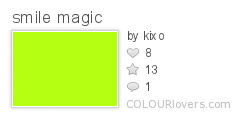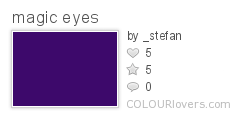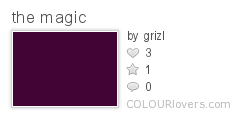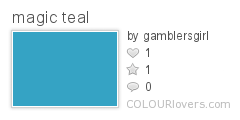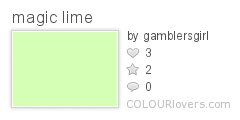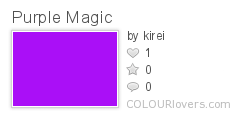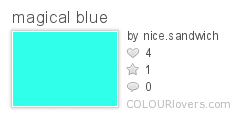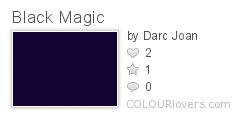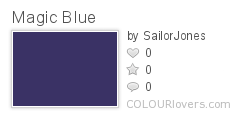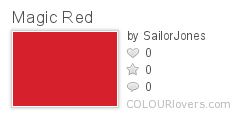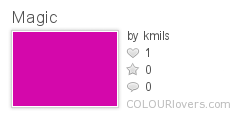“Octarine” is a color name coined by Terry Pratchett in his Discworld novels. Octarine is said to be the color of magic, as it is apparent in the crackling and shimmering of light. The word refers to the “eighth color,” in a spectrum of black, blue, green, yellow, purple, orange, and red. Octarine has been likened to a fluorescent greenish-yellow purple, a combination impossible to perceive with normal human eyes. Imagine, if you can, the marriage of these two swatches:
Scholar of magic Pete Carroll says he imagines Octarine to be “a particular shade of electric pinkish-purple,” a common color in optical illusions. Who can see octarine with the naked eye? Legend has it that only wizards and felines can. That’s because an ordinary eye, equipped with rods and cones, would see greenish-yellow purple as gray, black, or nothing at all, while a wizard’s eye is said to be equipped with octagons. Some people claim to catch glimpses of octarine in peacock feathers, lightning bolts, rainbows, lens flares, soap bubbles, bonfires, and gemstones.
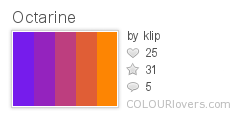 There can be no doubt that octarine is an imaginary color. But is it preposterous to think that normal human eyes might one day be able to perceive a fluorescent greenish-yellow purple? The folks at the Conscious Entities blog posed that very question: “There has to be an octarine, doesn’t there? The mere conceivability of another color shows that the spectrum is not an absolute reality. It seems to me that, just as we can always encounter a completely new smell, there would always be scope for a new color, if our eyes were able to develop new responses the way our nose presumably can. But I don’t even need to rely on conceivability. Some insects can see ultraviolet light, for example, and some snakes can see infrared. They must assign to those wavelengths colors which we can’t see, mustn’t they?”
There can be no doubt that octarine is an imaginary color. But is it preposterous to think that normal human eyes might one day be able to perceive a fluorescent greenish-yellow purple? The folks at the Conscious Entities blog posed that very question: “There has to be an octarine, doesn’t there? The mere conceivability of another color shows that the spectrum is not an absolute reality. It seems to me that, just as we can always encounter a completely new smell, there would always be scope for a new color, if our eyes were able to develop new responses the way our nose presumably can. But I don’t even need to rely on conceivability. Some insects can see ultraviolet light, for example, and some snakes can see infrared. They must assign to those wavelengths colors which we can’t see, mustn’t they?”
 Their conclusion, however, is negatory: “Look at the way the spectrum forms a closed circle. If we extended it downwards below red, we should simply get another, lower, violet. Now I grant you that the ‘lowerness’ would have to be expressed in some way – possibly as ‘warmth.’ The colors of the visible spectrum are differentiated in terms of warmth, so perhaps the lower violet would appear distinctly warmer than the one we’re used to (great scope for interior decorators…). I repeat, the spectrum is a reality. You can call it a mathematical reality if that helps, but it’s real. If we saw color the way we hear pitch, all this would be obvious. But the fact that we can’t see color harmonies or more than a single octave of colors means there’s never been any scope for a genius to come along and produce a regularized interpretation of the spectrum, the way J.S.Bach did for the musical scale.”
Their conclusion, however, is negatory: “Look at the way the spectrum forms a closed circle. If we extended it downwards below red, we should simply get another, lower, violet. Now I grant you that the ‘lowerness’ would have to be expressed in some way – possibly as ‘warmth.’ The colors of the visible spectrum are differentiated in terms of warmth, so perhaps the lower violet would appear distinctly warmer than the one we’re used to (great scope for interior decorators…). I repeat, the spectrum is a reality. You can call it a mathematical reality if that helps, but it’s real. If we saw color the way we hear pitch, all this would be obvious. But the fact that we can’t see color harmonies or more than a single octave of colors means there’s never been any scope for a genius to come along and produce a regularized interpretation of the spectrum, the way J.S.Bach did for the musical scale.”
The COLOURlovers library shimmers with magical colors, though as of this writing there’s no color named “octarine.” Some magic colors include:
Cover ![]() by Perla.
by Perla.
About the Guest Author, Craig Conley
Website:http://www.OneLetterWords.com
Craig is an independent scholar and author of dozens of strange and unusual books, including a unicorn field guide and a dictionary of magic words. He also loves color: Prof. Oddfellow
Are you inspired by the colors found here? Check out Creative Market to find some magical ideas for your project.
